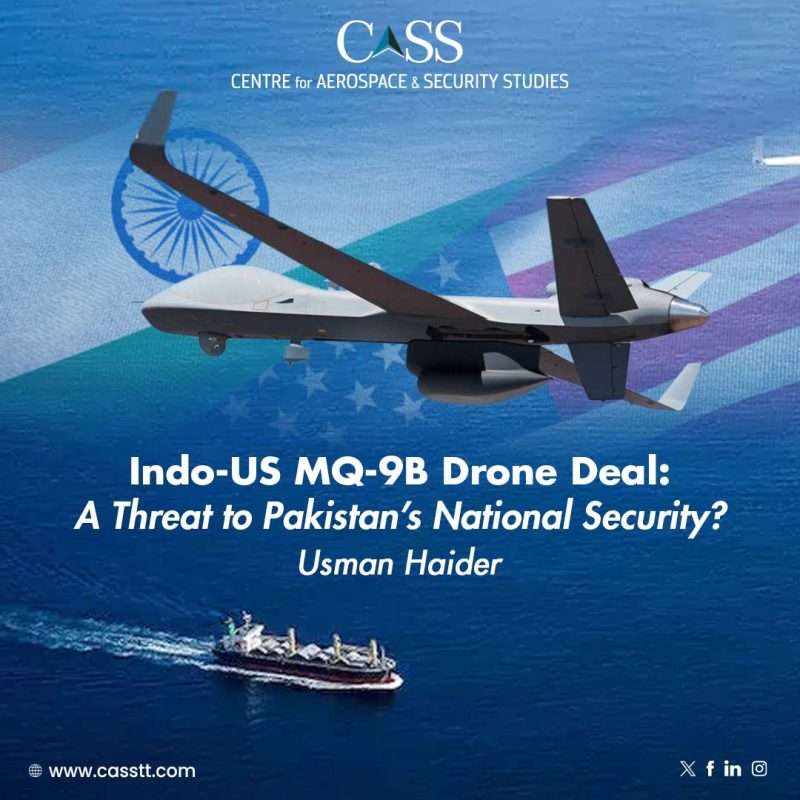The US government last month approved the deal of selling 31 MQ-9B drones to India for an amount of USD 3.99 billion. The agreement besides drones, also included 170 Hellfire AGMs, 310 GBU-39/B glide bombs, anti-submarine equipment, training kits and spare parts. As part of the transaction, the Indian military will get 16 Sky Guardian drones to be equally divided between the Indian Army and Air Force, whereas the Indian Navy will receive 15 Sea Guardian drones. The procurement is a manifestation of the Indian government’s ten-year defence plan under which it has allocated an amount of USD 250 billion to arm the Indian military with modern weapons. This article’s main premise is to analyse MQ-9B drones capabilities and to see how much it will enhance Indian war waging potential once they become operational.
The MQ-9B is the new generation drone among its competitors and can execute a variety of missions including kinetic and non-kinetic. It has a range in excess of 9260 kilometres (KM), and endurance of more than 40 hours but this can be varied as per mission requirements. The drone can carry 2514 kilograms (Kg) payload on its nineexternal and internal hard points. Moreover, it carries a specialised Lynx Radar which captures High Definition (HD) images and record videos in all weather conditions.
MQ-9B will be the first drone in Indian military service allowing it to perform multiple missions such as surgical strikes, reconnaissance and anti-submarine missions from a single platform. For instance, the Sky Guardian variant, capable of conducting missions on land frontiers will enable the Indian Army and IAF to track adversary’s military movements in real-time along India’s borders round-the-clock. Besides, it can be used for conducting precision strikes against both hardened and soft targets from the stand-off range. The stand-off capability is a value addition because it will allow the Indian military to hit targets without coming in contact with enemy air defences.
Similarly, Sea Guardians will allow the Indian Navy to perform maritime ISR and anti-submarine operations for extended periods. This will take the burden off from the limited inventory of P8I, which had been the primary anti-submarine aircraft until now. Moreover, it will be integrated with data-link 16 enabling it to effectively communicate and receive real-time data from the existing Indian Navy P8I Poseidon and MH-60 Seahawk airborne anti-submarine platforms.
In spite of its significant ranges and endurance, the Sea Guardian will continue to be threatened by sound air defence systems as well as the air borne radar (AI) equipped fighters, which it will find difficult to outrun. The recent shooting down of the US military MQ-9 Reaper by Iran-backed Houthis over the Red Sea region cast a question on MQ-9B’s survivability against modern air defence systems. The range and endurance are also likely to be affected at low altitudes which it will be forced to fly to avoid early detection by radars. In most cases, thus, the Sea Guardian would be restricted in operations in the open seas without compromising its survivability. However, at areas closer to the shore it would be able to perform effectively its anti-submarine missions for longer periods.
Despite improved inter-service operability, MQ-9B variants may continue to face some challenges for its seamlessutilisation because India lacks a dedicated facility to cater to maintenance and logistics requirements. Similarly, command and control issues are likely to hamper operational performance as neither the US nor Russia are expected to allow India to set up a direct communication and data link between their respective platforms. Although, the issue of information flow can be solved via a converter placed at a ground station or an airborne platform, however, the same may remain prone to interception and jamming, and is likely to affect the operational utility of MQ-9B drones.
Moreover, MQ-9B, although an enhanced version of the battle-proven MQ-9 Reaper, still lacks battlefield experience with no kill to its name. It has been selected by various states like UAE, UK, Belgium, and Japan but in fewer numbers. The US itself placed its first order in March 2023 for only three platforms, a relatively lower number compared to the 31 ordered by India. In addition, the system sale was also cancelled by the Australian government in 2022. Such developments overshadow the promise initially associated with the acquisition of MQ-9 B’s vis-a-vis its actual mission capabilities.
To sum up, the induction of MQ-9B in the Indian military will indeed augment India’s ISR and strike capabilities to quite an extent. However, as with most military systems it is also not without some limitations as discussed in previous paragraphs. How effectively India is able to exploit the system, while overcoming its limitations remains to be seen.
Usman Haider is a Research Assistant at the Centre for Aerospace & Security Studies (CASS), Islamabad, Pakistan. He can be reached at [email protected].





